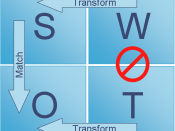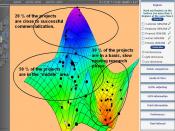The Leadership Improvement Plan is an excellent tool to utilize as a self-assessment plan for the manager of the future. An individual can assess or evaluate his or her strengths and deficiencies that would aid him or her in transforming themselves into the ideal manager in the future. In completing the self-assessments provided with the book, I ensured that I completed all of them so that I could receive a well-rounded analysis of my personality and my leadership potential. I took the liberty of approaching the Leadership Improvement Plan as I would a SWOT analysis of my organization. I ensured that I employed Porter's SWOT analysis to every aspect of my assessment. Typically, SWOT stands for strengths, weaknesses, opportunities and threats. A key to an effective SWOT analysis involves being realistic about your company's strengths and weaknesses, analysis should distinguish between where your organization is today, and where it could be in the future.
I avoided grey areas, always analyzed my current status in relation to my ideal vision of a manager in the pharmaceutical industry i.e. better than or worse than the ideal. I attempted to keep the analysis short and simple and ensured that the Leadership Improvement Process just like the SWOT process should avoid complexity and over analysis and that it is subjective.
In the future, I aspire to be in a leadership position in the pharmaceutical industry that actively enhances and promotes quality and compliance while ensuring that business objectives are met and exceeded. Some of the qualities required to be successful in this position are ethical decision making, ability to handle multiple projects at once, coping with change and adversity. Some of the weaknesses I have viewed in my managers are not being emotionally receptive, indecisiveness burnout and miscommunication in their directives and initiatives.
AM I A TYPE A?
In the assessment entitled, 'Am I a Type A?' the degree to which an individual is competitive and rushed for time is evaluated. The Type A personality describes an individual who is aggressively involved in continuous struggle to achieve more in less time (Robbins, 2004). Type A's are always moving, talking, and eating rapidly, feeling exasperated with the speed of most events, attempting to do multiple things at once, not coping well with leisure time, being obsessed with numbers, measuring their success in terms of how many or how much of everything they require (Robbins, 2004). Type B's are the complete opposites of Type A's.
I was evaluated as an A+ personality type as my score was among those who score 120 points or higher. Individuals who score less than 90 are Type Bs. As an A+ personality type, I need to be aware of my tendency to value quantity over quality. According to the assessment, I may perform better in jobs that are routine and depend on speed rather than creative ability for success. In addition, Type A's such as me often experience moderate to high levels of stress. My strength is that I can wrap up multiple projects at once. However, the quality of my project routinely may not fully meet the requirements or result in dissatisfaction among the end users or customers.
As a Type A+, I need to carefully plan or outline all aspects of the project and set realistic timelines and milestones that focus more on the quality of the product produced and the process involved. Rather than rushing through the projects and meeting the deadline, I should learn to set my own pace so that I may be able to enjoy my leisure time as well. I would like to remedy some aspects of my A+ personality that I deem to be undesirable such as always moving, walking and eating rapidly and striving to do multiple tasks at once.
THE JUNG-MYERS-BRIGGS TYPE INDICATOR (MBTI)
In the 'The Jung-Myers-Briggs Type Indicator (MBTI) assessment', a personality test is provided that measures how people behave in different situations by asking them to respond with how they feel or behave in the scenarios described in the test questions (Robbins, 2004). The test has four major classifications: introversion vs. extroversion (E vs. I), sense vs. intuition (S vs. N), thought vs. emotion (T vs. F) and perception vs. judgment (P vs. J). The test identifies the dominant trait in each classification to come up with a four-letter personality indicator such as ENFJ or INTJ (Robbins, 2004).
I was deemed to be an ISTJ on the Myers-Briggs Type Indicator. This result can aid me understanding my personality, my strengths, and weaknesses. It can help me in making successful career decisions when I try to find jobs that align well with my strengths and avoid those jobs that are a poor fit.
As an ISTJ, I seem to perform at highest efficiency when employing a step-by-step approach. Once a new procedure has been tested for repeatability, I can be relied upon to carry it through, even at the expense of my own health. My drawbacks as a leader include lack of some of the characteristics of extroversion such as being sociable, gregarious and assertive. My plan for improvement is to take steps in seeking balance of my introversion with some aspects of extroversion.
As an ISTJ, I am easily frustrated by the inconsistencies of others, especially when other individuals who do not keep their commitments. However, I usually tend to keep my feelings to myself unless I am asked. And when asked, I am harsh in my words. I have grim determination and focus that aids me when required to make tough calls and sticking to them. Some famous ISTJs are Presidents George W. Bush and George Washington.
WHAT'S MY EMOTIONAL INTELLIGENCE SCORE?
In the assessment entitled, 'What's my emotional intelligence score?' I learned that emotional intelligence is repertoire of skills that help people succeed throughout life in all scenarios (Robbins, 2004). Emotional intelligence is a set of acquired skills and competencies that are predictors of positive outcomes at home with one's family, in school, and at work (Robbins, 2004). People who have these skills are healthier, less depressed, more productive at work, and have healthier relationships. Individuals who have low EI may have difficulty managing others, making effective presentations, and teamwork (Robbins, 2004).
I achieved a score of 36 on the Emotional Intelligence test, 40 or above being considered a high score. A score of 40 or higher indicates a high EI. The highest score is 50 and the lowest score is 10 where scores lower than 20 are considered low. I will take corrective action in order to ensure that I achieve a high EI score and maintain it as individuals with high EI possess the ability to accurately perceive, evaluate, express, and regulate emotions and feelings. As a future quality assurance manager in the pharmaceutical industry, I must learn to channel my personal emotions and feelings and not allow them to negatively influence my decision-making. Additionally, I must be able to accurately evaluate other individuals in my organization and their performance. The pharmaceutical industry is continuously changing with mergers, acquisitions and exciting new technologies. As a manager, I must be receptive to these changes and ensure that I communicate my decisions and views effectively in order for those to be implemented and communicated without misinterpretation. In the pharmaceutical industry, a majority of the work relies on teamwork. With a higher EI, I should be able to actively enhance quality presence and compliance within the organization by communicating the deficiencies and proposing innovative new solutions to remedy them.
HOW ARE YOUR ETHICS?
The assessment entitled 'How are your ethics?' measures or rates my response as compared to mean responses from a group of 243 management students. Additionally, this assessment provides insights on how my ethical standards match other people with whom I may be working with in the future. The importance of ethics in the business world is critical.
Based on my responses, I believe that I tend to be less ethical than the student norms presented in the assessment. For example, I strongly agree that the competitiveness and profitability are important values and my corresponding score was 5. However, the student group response was lower with the value of 3.62. There were no other large discrepancies.
In the pharmaceutical industry, decisions are made that can have direct impact on a patient's health. Pharmaceutical industry is mandated by law to uphold the health of the general public and to make quality drugs and devices that prolong the health and lives of millions of Americans. Any contamination or misbranding of product may lead to illness or death. My leadership improvement plan involves working for a company that highly values ethics in its decision-making and takes into account the interests of all its stakeholders such as employees, community, environment and not just its shareholders. As a manager of the future, I need to have ethics play a key role in my professional development and decision-making abilities. A company such as Johnson & Johnson with an established set of ethical code or credo is an ideal environment where I can incorporate ethics in my professional and personal life. Johnson & Johnson has proven that it operates within the guidelines of its company credo which claims that it first responsibility is to the patients who take its products.
HOW GOOD AM I AT BUILDING AND LEADING A TEAM?
The assessment evaluates team development behaviors in five areas such as diagnosing team development, managing the forming stage, managing the storming stage and managing the performing stage (Robbins, 2004). The score ranges from 18 to 108 and it can help measure my aptitude at building and leading a team in comparison to a group of 500 students.
My score on this assessment was 86, placing me in the second quartile (72-94). A score of 95 or above would have placed me in the top quartile. A score of 60 or below is the bottom quartile indicating a deficiency in effectively managing and leading a team. I believe that I am well versed in the different stages of development that teams undergo in their life cycle from initiation to disbanding. Also, I am knowledgeable about guiding the team during the trying stages of forming and storming. My experience as a team leader in a Six Sigma project and Six Sigma Black Belt certification from the American Society for Quality is considerable.
One of my strengths is that I give immense feedback to team members regarding their performance and help them hone their skills and facilitate unfettered exchange of ideas. One of my weaknesses is that I often cannot exude a certain charisma or passion required to communicate an exciting and passionate vision of what the team can achieve. Some action I can take is to practice yoga and meditation on a regularly in order to focus my mind on the positive and gain a sense of optimism for the future. I can also review how successful managers exude their charisma and passion to obtain buy-in from their employees and team members. One of the books I can read is 'Creating Optimism: A Proven, Seven-Step Program for Overcoming Depression' written by Bob Murray and Alicia Fortinberry. By doing exercises in the book, I will gain a new positive outlook of life. I wish to learn and experience new and more positive ways of looking at my past, at my relationships, at my work, at my family.
HOW GOOD ARE MY LISTENING SKILLS?
In the assessment entitled, 'How good are my listening skills?' the insight into the individual's listening skills was provided based on scores ranging from 15 to 75 (Robbins, 2004). It is usually the case that effective communicators have developed enhanced listening skills. My score of 43 is indicative of fairly well developed listening skills. However, they are not well honed. A score of 60 or above is not very common. It is the mark of an individual who is well tuned to the thoughts and needs of others and is able to listen attentively and show empathy if needed as well. If my score were less than 40, I would have to critically examine the deficiencies in my listening skills and embark on a serious and concerted attempt at bringing them up to par.
A manager in the pharmaceutical industry must be in constant contact with his employees, fellow managers, supervisors and customers. If he or she is not willing to devote the time and energy to listen attentively to the concerns or ideas of these stakeholders, then he or she will not employed in that position for a long time. If he or she appears distracted or disinterested, it will be dissuade the others individual from relaying their concerns, ideas, and critical information and turn to someone else who is more willing to invest the time and energy to do so.
To fine tune my skills, I shall attempt to engage in active and astute listening and attempt to make a strong effort to display genuine interest in listening to the stakeholders rather than pretending or faking it. I will make a concerted effort to evaluate and formulate a response to what is being said and when it is being said.
WHAT'S MY PREFERRED CONFLICT HANDLING STYLE?
In the assessment entitled, 'What's my preferred conflict handling style?' I was relieved to discover that my scores were indicative of an individual who employs all the five styles in an equitable manner to achieve team goals during team conflict. The scores range from 4 to 20. The five conflict-handling styles are competing, collaborating, avoiding, accommodating and compromising. My scores on the collaborating, accommodating, and compromising were 16. I scored a little lower on competing and avoiding with 15. The category that an individual scores the highest in is his or her preferred conflict-handling style. The next highest total is the individual's secondary style. It is considered ideal for an individual to be posses the ability to adjust his or her conflict handling style based on the situation at hand. An ideal manager must be able to gauge the team situation and assess what his or her conflict resolution style should be. For example, avoidance works well when emotions are running high and time is needed to cool them down, or when the potential disruption from a more assertive action outweighs the benefits of a resolution (Robbins, 2004). In contrast, competing works well when you need a quick resolution on important issues where unpopular actions must be taken, or when commitment by others to your solution is not cordial (Robbins, 2004). If I am solely accommodating in my approach to conflict, then I am yielding or conceding and it is a no-win situation where neither parties benefit.
Usually, I use the collaborative approach and tend to avoid the competitive approach. A collaborative approach results in win-win situations where there are active efforts by both sides to find a solution in which the needs of both or all parties are completely met (Robbins, 2004). For matters that are critical to the project, I would not engage or encourage avoidance style, as it is detrimental to the efforts of the team and the success of the project.
CONCLUSION
In conclusion, my leadership improvement plan would comprise of varying facets of professional and personal adjustments that would enable me to prepare and align with my vision of an ideal manager. In summarizing my results, I discover that I need a well-rounded approach to tackle some of the deficiencies I have. I have to attend emotional intelligence workshops, take courses in ethics, read books, and consider enrollment in management training programs. Additionally, I need to hone my skills in the areas I have competence or mastery in order to avoid having them dull over time.
I believe that evaluating my strengths, weaknesses, opportunities and threats continually in the future as I have done so with the Leadership Improvement Plan here will greatly aid me in my aspirations of realizing and sustaining a successful and effective managerial position.



Leadership plan
A lot of good points but a bit too lengthy
0 out of 0 people found this comment useful.